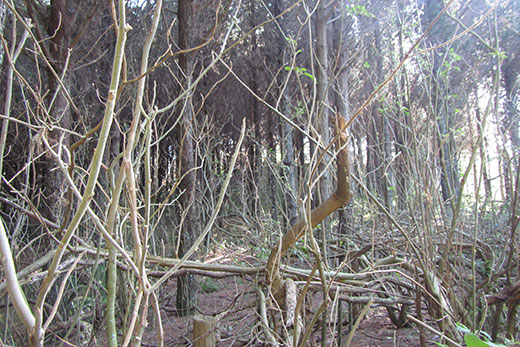Bay of Plenty Regional Council's trials of using lace bugs to decimate the spread of woolly nightshade on properties in the region are producing promising results – especially for forest owners.
But the council warns traditional control of the pest plant is still needed, with the onus now on landowners to stump the full cost of control on their properties after a subsidy for the work was phased out.
Lace bugs are proving useful for helping to control woolly nightshade.
BOPRC land management officer Andrew Blayney says BOPRC can't supply lace bugs for use on all properties in the Bay of Plenty.
"But once established in our worst-affected areas, they [lace bugs] should help reduce large weed infestations and will disperse naturally on to surrounding properties over time.”
Andrew says heavy damage to woolly nightshade is being seen at a Welcome Bay property this year, following the release of 300 lace bugs at the site in 2010.
'It's a landowner's responsibility to control woolly nightshade on their own property. We help them do that as effectively as possible, such as by testing new control methods,” says Andrew.
'We're one of the first regions to use the lace bug through the National Biocontrol Collective.
'We knew it would take some time to see the results, but this year we're really starting to see the bugs make an impact across the whole 70 hectare site.”
Andrew says the bug-fighting method is part of council's work to keep woolly nightshade in check throughout the Bay of Plenty.
'We're increasing our surveillance, compliance and biological control development efforts now, instead of directly subsidising landowner control efforts.”
Woolly nightshade is a problem weed because of its ability to grow in dense stands that crowd out more desirable pasture and forest plants.
It's also covered in fine hairs, which can cause skin, eye, nose and throat irritations for people and stock who come into contact with it.
The lace bugs feed on the leaves of woolly nightshade, drying them out and stunting the growth of the plant.
This prevents plant reproduction, reducing spread, and can eventually cause the plant to die, says Andrew.
'We're getting better results from the lace bugs here than in other parts of the country.
'They're doing especially well in shaded areas, such as under pine trees. That's a good sign because controlling woolly nightshade in pine blocks has been difficult to date.”

BOPRC trials are showing lace bugs can decimate woolly nightshade.
But Andrew says traditional control is still needed.
'We can't supply lace bugs for use on all properties in the Bay of Plenty, but once established in our worst-affected areas, they should help reduce large weed infestations and will disperse naturally on to surrounding properties over time.”
Andrew says the next release sites will be large pine blocks infested with woolly nightshade.
'We'd love to hear from anyone that has a suitable site,” says Andrew.
The 2010 Bay of Plenty lace bug release was completed via the National Biocontrol Collective, made up of regional councils, unitary authorities and the Department of Conservation working together with New Zealand Landcare Research, which leads lab testing and breeding.
'Lace bug is originally from South America. We followed a really rigorous process before releasing it here – that included 10 years of research by NZLR, consultation with iwi and approval by the Environmental Risk Management Authority,” says Andrew.
Bay of Plenty land occupiers are legally responsible for controlling woolly nightshade on their own properties.
Information on controlling woolly nightshade and other weeds is available at www.boprc.govt.nz/pestplants or by calling a Land Management Officer on 0800 884 880.



1 comment
Overit
Posted on 18-08-2014 12:22 | By overit
Council sort out gorse on your land too.
Leave a Comment
You must be logged in to make a comment.